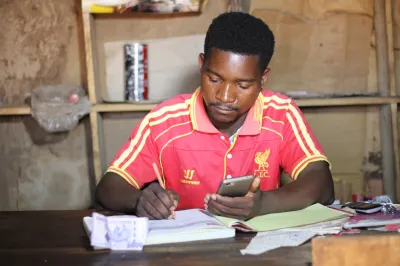What is USSD & Why Does it Matter for Mobile Financial Services?
USSD – unstructured supplementary service data. It sounds a bit complicated, and can get technical very quickly, but for the purposes of financial inclusion, there are two key things to understand. First, when you dial a number that starts with * and ends with #, you are using USSD. Second, USSD is currently the best available communications technology to deliver mobile financial services to low-income customers.
With the notable exception of M-Pesa in Kenya, the majority of large scale mobile financial services (MFS) deployments in the developing world use USSD as their primary mechanism for communication between customers and their mobile payments platform. These include bKash in Bangladesh; Wing in Cambodia; EasyPaisa in Pakistan; Tigo and M-Pesa in Tanzania and EcoCash in Zimbabwe, to name a few.
GSMA and others have documented the success of MNO-led business models to advance financial inclusion – with a number of countries having registered more mobile money accounts in a matter of years than bank accounts opened in decades. From my perspective this is clearly positive for financial inclusion. However a potential regulatory concern arises when MNOs not only compete in the provision of MFS, but also control a key input competitors need to offer these services – namely the communications infrastructure, and specifically USSD. The issue is more pronounced in countries where the MNO has market power in telecommunications, meaning constraining access to USSD (by withholding access, charging a high price or offering poor quality USSD) could prevent the MNO’s competitors in MFS from reaching scale. This can effectively block customers from realizing the potential benefits of competition (such as lower prices, increased investment in agents, improved service levels, customer choice and product innovation).


Over the past months CGAP has explored this issue. This Brief, which builds on an earlier Working Paper commissioned to Genesis Analytics, outlines the findings from that work, with some key takeaways mentioned below.
First, as mentioned above, our research supports the notion that USSD is currently still the best communication technology available to provide MFS to low-income individuals. Smartphone applications that connect users with providers through the internet still exclude the vast majority of the poor, while Short Message Service (SMS) has security and user experience shortcomings compared to USSD.
Second, MNOs have practical reasons (such as concerns over network congestion) and strategic reasons (such as the desire to leverage USSD control as a competitive advantage in the provision of mobile payments) for withholding effective USSD access.
Third, whether regulatory intervention is required is a complex matter requiring country-specific context. Regulatory coordination between the telecommunications, financial, and competition regulators is critical when evaluating the USSD issue.
Finally, regulators pondering USSD access should consider the following progression of options to promote healthier access to USSD.
- Encourage market forces. The best outcome for any market is for commercial agreements to emerge between MNOs and third parties. This would advance competition and the development of the MFS market without placing restrictions on MNOs. Access to USSD is a technically and commercially complex issue that market players ideally can sort out amongst themselves. Some encouragement to sort it out directly may lead to the best outcome for all concerned.
- Introduce a dispute resolution mechanism (DRM). In markets where commercial agreements are not forthcoming within a reasonable time, a coordinated dispute resolution mechanism could be useful to allow the regulator(s) to understand the considerations of all stakeholders. A DRM would be able to hear a balanced set of views from market participants and recommend ways forward without introducing a heavy hand of regulation.
- Explore regulatory options. In the event that a DRM does not result in a mutually agreeable outcome, and the non-provision of USSD is found to seriously hamper competition, regulatory intervention may be justified. In such instances, the most effective intervention may be to mandate that MNOs provide access to USSD, without regulating the price. In some extreme cases regulators may in time be pushed to set minimum quality standards and pricing rules (such as requiring that USSD prices are applied in a nondiscriminatory fashion) to foster healthier competition.




Comments
Hello Michael,
Hello Michael,
First of all I would like to say that you wrote a great article and you did hit the spot. I am working as a USSD Specialist for a service provider Infobip and we are working on USSD projects in a lot of countries around the world. MNOs often present the key challenge. They do not have the right technology, as a step one, and there is often complicated administration, making the service launch very often postponed. Because of that, companies dealing with MFS have a lot of costs involved. There is also no interconnection between them for USSD, so every single operator needs to be approached to cover the whole country with the service.
Correct Filip, Wing had that
Correct Filip, Wing had that exact challenge with MNOs; to reach the entire population requires separate USSD connections to each.
One other relatively unknown but brilliant feature of USSD is that the commands always route back to the host country when roaming. I can still access my Wing account in Cambodia via USSD when traveling overseas- I used it on my last trip to top up my Visa card & pay my electricity bill!
Michael, very interesting
Michael, very interesting analysis, you highlighted the main barriers on this market. However, other emerging technologies are offering improvements in security and on customer experience, as is the case of NSDT (Near Sound Date Transfer) which uses the voice channel to perform a highly secure transaction using an audio OTP. As it uses the audio channel, any type of phone can be used, even the most basic one.
Nice analysis Michael. Your
Nice analysis Michael. Your points show that USSD faces a huge hurdle if its deployment depends on having the MNOs agree on the MFS project. NSDT is a Contactless Sound Based Technology that is operator agnostic. At Tagattitude our Mobile Financial Service Platform uses USSD and NSDT in order to bring Financial Services to market very quickly and independently from phone type (feature or smartphone) and MNOs.
Very usedful.
Very usedful.
Antony, thank you for your
Antony, thank you for your feedback. Disadvantage of connecting to all MNOs becomes an advantage when you launch the service. MNOs can not compete with their Mobile Money projects with you because they can offer the service only to their subscribers. On the other hand, you can cover the whole market. Also, can you share with us your experience with operators in Cambodia? How is the market regulated? Did you need to visit the regulator or you needed to go directly to the operators to get the USSD short code (as I can see it is *989#)? Did you had any problems because of the service type you were performing over USSD?
Interesting and informative
Interesting and informative article!
Great article!
Great article!
Add new comment